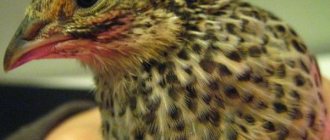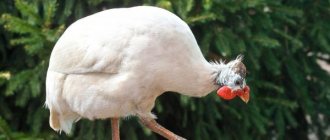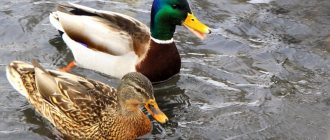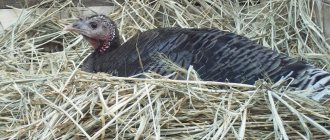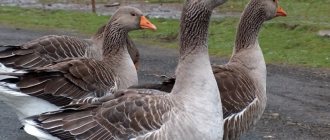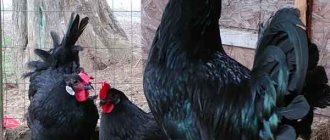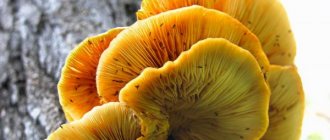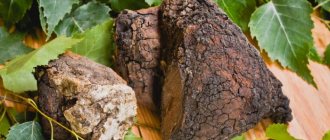Turkeys are birds that are perfect for raising for sale. The body weight of adult individuals reaches 30-35 kilograms! Tender dietary poultry meat has gained popularity around the world due to its excellent taste and invaluable nutritional value. To successfully raise turkeys and grow their business, poultry farmers need to know how to tell a gobbler from a turkey. Let's talk about existing methods for determining the sex of birds in the article.
How to distinguish a turkey from a turkey
Method No. 1 - by genitals
The method of determining the sex of turkey poults is popularly called Japanese. To examine the chick's cloaca, hold it upside down in your hand. Gently stretch the bird's cloaca and examine or feel the genitals. The female's genitalia are represented by two pink folds, the male's - by paired tubercles of a reddish hue, which are easy to feel.
Genitalia of day-old turkeys. No. 3 - male, No. 4 - turkey
How to determine the sex of turkey poults
The ideal time to identify the sex of turkey poults is 6–16 hours after birth. If the procedure is carried out later, the process becomes more difficult, since the sexual characteristics of birds tend to smooth out over time.
Determining the sex of a turkey poult by the genital tubercles:
- The turkey's intestines must be emptied before starting the procedure.
- You should lightly press on the chick's abdomen and sides and remove any remaining droppings.
- If the examiner is right-handed, then you need to hold the turkey with your right hand, with its head between the ring finger and little finger, and the paws sandwiched between the middle and index fingers. Care must be taken not to squeeze the chick too tightly.
- Then the examiner needs to properly open the turkey's cloaca. This is done with the thumb of the index finger of the free hand. The genital tubercle is located inside the cloaca in the lower part.
- Boys have two genital tubercles, while girls have only one, which is not very pronounced.
If determining the sex using the first method seems difficult, then this can be done later, a day after their birth . This is done by examining the feathers of the chicks. In turkeys, the feathers of the last row grow more evenly than in turkeys, in which they become even out over time.
After two weeks of life of the chicks, it is possible to determine their sex by the comb. In turkeys it is well defined, bright and shiny. Turkey coral is more faded and smaller.
Method No. 2 - according to the length of the feathers in the wing
A method proven by many generations of domestic and foreign poultry farmers. It is successfully used in small private farms, on farms with large livestock and on an industrial scale. It is used from the first day of life of chicks and gives a high percentage of correct cases of sex determination.
Sex determination based on the length of the flight feathers is relevant for day-old chicks
To understand whether the bird in front of you is a turkey or a turkey, carefully take the chick by the wing and examine the feathers, namely, the outermost row. If you see feathers of the same length, this is a future turkey. Feathers of different lengths are found only on the wings of females.
Note! The older the birds get, the smoother the row of feathers looks in both sexes. As a result, the method described in this section loses its relevance. It is impossible to determine the sex of adults using it.
At what age should you buy turkey poults?
Methods for distinguishing sex in turkeys
To determine the sex of birds, it is recommended to take into account many features - first of all, appearance and behavior.
By external signs
Determining the sex of birds will not be difficult even for inexperienced farmers. Many people believe that it is much easier to focus on size differences, since males are much larger than females. But this rule does not always work.
Expert opinion
Zarechny Maxim Valerievich
Agronomist with 12 years of experience. Our best country expert.
Ask a Question
Even with differences in diet, females are able to catch up with the weight of large males. At the same time, adult turkeys sometimes do not gain body weight well and end up small and thin.
The main sign of a male is the presence of a special growth above the beak. It is called coral. This is a process that has a crimson hue. It hangs from the beak. With increased emotional arousal, the process increases to 15 centimeters in length. The feathers of birds are also significantly different. Males have a tuft of thread-like feathers on the chest and spurs. At the same time, a characteristic feature of turkeys is the almost complete absence of feathers on the head.
The comb also differs based on gender. Males have a bright red crest, while females are paler and smaller. Another parameter for determining gender is the appearance of the chin. Males have a leathery pocket at the bottom of the neck. In one-year-old turkeys it cannot be distinguished from the neck. To see the pocket, you need to lift it with your hand. In a turkey, this part sags by 2-3 centimeters.
See also
Types of turkey feed from Purina and how to make the composition yourselfRead
By the fullness of the tail
The tail helps reveal the sex of birds. Females have a less lush and beautiful tail compared to males. At the same time, the feathers on the tail of turkeys are amazingly beautiful. They are smooth and dense.
By spurs and litter volume
To distinguish between females and males, it is worth considering the presence of spurs. In females they are extremely rare. To a greater extent, birds are characterized by soft feathers. Moreover, males have sharp spurs. Another way to identify sex is to estimate the number of litters. The age of the birds is not important in this case. In males, the droppings have a denser texture and smaller volumes. It lies in a "J" shape. Females are characterized by a larger number of litters. In this case, it usually forms a “slide”. The stool looks like chicken stool.
By habits
The difference between the birds is also present in their habits. Female turkeys are characterized by a collective behavior. They usually form groups of varying sizes depending on the number of birds. It is the females who exhibit more aggressive behavior. If turkeys form a group, they are able to peck other poultry - for example, chickens or roosters. Similar differences in behavior appear in adulthood. This method of gender assessment is usually used only by professionals.
It is worth considering that it is important to separate females from males at 5-6 months - this will help to avoid traumatic injuries.
During breeding, the behavior of males changes. They make cooing sounds and draw circles on the ground. This confirms the turkeys are ready to mate.
By size of individual
To distinguish girls from boys, you should focus on their sizes. The live weight of adult males can be 35 kilograms, and females - 11. At 5-6 months they are the same size. Therefore, it is important to take other features into account.
See also
How and from what you can make a drinking bowl for turkeys with your own hands, instructionsRead
In young years
The easiest way is to estimate the sex of day-old turkey poults. This can be done using the Japanese method. To do this, it is recommended to stretch the cloaca and find the genitals with your fingers. In females it is possible to find 2 folds fastened to each other. Their genital organ is more elongated and characterized by a loose structure. In turkeys, there are 2 small roundnesses in the opening, which are called genital tubercles. This method requires knowledge and skills, but is 100% effective.
It is recommended to examine the genital organs of chicks very carefully to avoid traumatic injuries. On large farms, this manipulation is performed by a veterinarian. Inspection of one chick takes a maximum of 2 seconds. This method of gender identification is used from birth.
In a 1-week-old chick, the sex can be determined by the size of its feathers. In males, the outer feathers on the wings are of equal length. However, experts say that this method is only 70% effective. After some time, the length evens out and does not depend on gender. Therefore, there is a risk of missing this moment.
At an older age, it can be more difficult to distinguish turkey poults. Therefore, it is best to determine their gender at an early age. This should be done in 1 day.
To divide 1 month old chicks into 2 categories, you can use a special device. It involves the use of ultrasonic influence. Turkeys and turkeys have a number of differences. To identify the sex of birds, it is recommended to take into account their appearance, feather size, comb and tail. There is also a difference in behavior that helps distinguish males and females.
Method No. 3 - according to the abundance and shape of the litter
This unusual method of determination was invented by American poultry farmers, who traced interesting patterns associated with the amount of droppings left by individuals of each sex, as well as with the shape of the heaps.
Turkey droppings resemble the letter "J" and the turkey is defecating in piles.
Thus, the feces left by a female turkey will be abundant and will fall on the ground in a heap, similar to the droppings of chickens. Females defecate more often than males. The droppings of male turkeys are not as abundant, but their consistency is noticeably denser. Interestingly, heaps of turkeys often remain on the ground, forming a "J" shape.
This determination method works really effectively, but is not 100% accurate. If you have a female in front of you, then the amount of her feces will not always be significant, and if it is a male, then the droppings will not necessarily form a letter of the English alphabet.
Below is a comparative table of turkey droppings, which differ depending on the sex of the bird.
| Gender of the bird | Abundance of droppings | Litter shape |
| Male | Abundant droppings, frequent large piles on the site | The droppings are located in piles, similar to chicken droppings. |
| Female | The droppings are dense, but not abundant. Turkeys defecate less often than turkeys. | Turkey feces are often located on the ground in the shape of the letter "J" of the English alphabet. |
Turkey and turkey: what's the difference?
If we consider the question from the point of view of semantic load, then there are no differences between the words “turkey” and “turkey”.
In the explanatory dictionary edited by D. N. Ushakov, two words appear.
Meanings of the word "turkey":
- Female turkey.
- Its meat is like food.
Meaning of the word "turkey":
- Turkey meat as food.
- Same as turkey in 1 value.
There is also the word “turkey” - this is also turkey meat.
There are two popular opinions according to which these names have different shades of meaning:
- It is believed that a live bird is called a turkey, and a ready-made dish is called a turkey: a turkey is served at the table, and a turkey is bred at home.
- Some people think that turkey is a wild bird and turkey is domesticated.
Method No. 4 - by weight
Price for kitchen electronic scales
Kitchen electronic scales
A method that begins to be used from two months of bird age. During this period of development, females noticeably begin to lag behind males in weight. The differences are visible to the naked eye. If you are not sure of their correctness, use a scale. By weighing different individuals and comparing the scales, you will understand exactly who is in front of you - a turkey or a turkey.
The difference in weight between a turkey and a turkey can be 10 kilograms or more
How to distinguish a turkey from a turkey among hatched chicks
Inexperienced poultry farmers find it difficult to determine the sex of newborns and do not know how to distinguish turkey poults. You can find out exactly where the males are and where the females are only after they reach 5 months of age.
However, there is a proven method that can be used immediately after the litter has hatched. It is necessary to carefully examine the genitals of the birds: to do this, carefully spread the cloaca of the individual with your fingers. The turkey’s genitals are bright red, while the girl’s have two tightly connected pink folds.
Poultry farmers use the folk method of determining sex by the feathering of the wings. You need to unfold the chick’s wing and look at the edges of the feathers: if the frame is even, then it’s a male, if it’s uneven, it’s a female.
There are behavioral differences in the behavior of young individuals. Boys keep to themselves, girls gather in flocks.
Method No. 5 - according to the expressed gland
In male turkeys at the age of five months, a special gland is felt by palpation of the neck, which feels like a dense, small wart. When examining females, it cannot be found, so the method is one hundred percent accurate. At the same time, it is perfect for poultry farmers, since turkeys need to be separated from turkeys at the age of 5-6 months.
A dense gland can be felt on the neck of a turkey
Tail feathers and comb
The turkey has a small comb that is faded in color. In the male, the comb shines brightly, has a bright color and is directly important in very warm seasons, especially with the onset of spring.
When a turkey reaches two years of age, it differs from a turkey by 70%. The birds are actively developing differences, so an experienced farmer can easily determine the sex of the bird.
The female's tail is not very bushy, but the male's is attractive and impressive. The male tail has dense, beautiful and absolutely even feathers.
Turkeys are much larger than turkeys
Method No. 6 - according to the degree of feathering of the head
When they reach the age of 2 months, turkeys and turkey hens acquire another characteristic difference, in addition to weight. The turkey's head will be covered with soft down, giving the bird's appearance a special softness. The surface of the turkey's head will remain unfeathered.
The turkey's head is bald, but the turkey's is covered with fluff.
Method No. 7 - along the nasal process
Even a child can distinguish a turkey from other types of poultry. He will do this along the characteristic nasal process, located on the bird’s head, and hanging down to the chest area.
Large nasal growths in birds resemble large fleshy warts in appearance. Turkeys do not have such decoration. Based on this feature, it will be easy for a novice poultry farmer to distinguish a turkey from a turkey.
The nasal process of a turkey reaches the chest area
Method No. 8 - on behavior before mating
The period of hunting in turkeys is characterized by the appearance of various behavioral features. Surprisingly, the female starts the flirting first. She begins to coo songs to the turkey, turning circles around her chosen one, and then gently pecks him in the area of the nasal growth. Attractive dances serve as a signal to slow-moving turkeys that the female is ready to mate and give birth to offspring.
The experience of some poultry farmers shows that turkeys do not care who exactly becomes the father of their chickens. Before starting the dance, females look closely at the males for a long time, choosing the only one, and then begin courtship.
The turkey is the first to show signs of attention to the turkey
The behavior of males is also specific. As soon as the turkeys realize that they have been chosen as one of the turkeys, their excitement reaches a peak. The nasal process swells, filling with blood. The male fluffs up and proudly, with a slow gait, walks towards the turkey. The bird's tail feathers rise vertically to the surface of the ground and open like a fan. With its wings, the turkey draws small circles on the ground and bubbles, letting the female know that it is ready to mate.
Video - Turkeys trample a turkey and dance
Method No. 9 - on the plumage of the body of birds
Over time, the plumage of turkeys and turkeys becomes strikingly different. For example, males have thick feathers on their chests that puff up during fights and sexual hunting, while females have sparse, soft feathers in this area.
The distance from the crop to the male's chest is covered with tassels of feathers.
The plumage of turkeys is more magnificent than that of turkeys
Method No. 10 - based on the presence of spurs on the legs
Sharp spurs are the calling card of males of many bird species. The turkey was no exception and was gifted by nature with these sharp tools of protection from enemies. Females do not have spurs on their legs, because their duty is to produce offspring, and turkeys are to protect their chosen ones and children.
With the help of spurs, the turkey protects his chosen ones
Method No. 13 - according to the behavioral characteristics of adults
The characteristics described in this section become relevant only when the birds reach sexual maturity. It is typical for mature females to:
- get together in groups;
- constantly communicate with friends;
- aggressive behavior.
Turkeys and turkey hens behave differently
Everything is not like with people. Masculine, confident behavior is typical for turkeys, but males behave truly feminine:
- behave calmly in the poultry yard;
- are reluctant to get into fights;
- they walk alone.
Do birds differ depending on their habitat?
Scientists compared turkeys bred on Russian farms with American birds. No particular discrepancies were found, but sometimes the breeds that are bred in Russia are called turkeys, and the American ones are called turkeys.
Among the popular breeds in our country are:
- Moscow white. Turkeys are not very heavy, but are easy to breed. The female lays eggs well, and the eggs do not require special conditions for ripening. The breed tolerates severe weather conditions well.
- North Caucasian bronze. The bird gains weight well in pasture conditions, which significantly saves money on feed in the summer. This is one of the largest breeds in Russia: males reach a weight of 14 kg, females - 7 kg.
- White, broad-chested. It is unpretentious to weather conditions and tolerates cold better than others. Within the same breed there are small, medium and large turkeys.
Be sure to read:
Turkeys: features of care, cultivation and breeding at home
Summarizing
To run a successful business, every farmer must know how to tell a turkey from a turkey. This will help him place males and females in time to avoid uncontrolled breeding and the production of sickly, low-productive offspring. If you are raising chicks for sale, this skill will also come in handy. Carefully read the effective methods described above and choose the appropriate one. Each method has been tested by turkey farmers around the world. Good luck!
External differences between the heads of male and female turkeys
